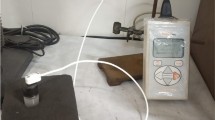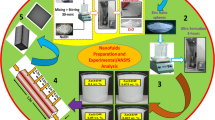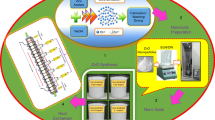Abstract
Development of alternative working fluids with enhanced thermal properties is very much needed to replace conventional fluids. Colloidal solution of some base fluid with solid nanoparticles dispersed in it, which is called as nanofluid, is emerging as a promising alternative heat transfer fluid. Zinc, being ecofriendly material, is selected as dispersed phase in water to develop zinc–water (Zn–H2O) nanofluid. Zn–H2O nanofluid is synthesized by single step method and characterized. Thermophysical properties are estimated by available theoretical models. Estimated properties proved that nanofluid is having enhanced thermophysical properties compared to the base fluid due to which nanofluid can become potential working fluid for heat exchanging devices. Synthesized nanofluid is circulated through heat transfer loop to assess its performance in turbulent flow regime and at constant wall temperature condition. Heat transfer coefficient and pressure drop are estimated from experimental results and both are considered as performance evaluation criteria for heat transfer performance assessment. 83 % increase in Nusselt number with 9 % increase in pressure drop is observed for the nanofluid compared to water.






Similar content being viewed by others
Abbreviations
- ∆P:
-
Pressure drop (Pa)
- ∆Tm :
-
Logarithmic mean temperature difference (K)
- As :
-
Surface area (m2)
- Cp :
-
Specific heat (J/kg K)
- D:
-
Diameter of test section (m)
- f:
-
Friction factor
- K:
-
Thermal conductivity (W/m K)
- L:
-
Length of the test section (m)
- Nu:
-
Nusselts number
- Re:
-
Reynolds number
- T:
-
Temperature (K)
- μ:
-
Dynamic viscosity (Pa s)
- ρ:
-
Density (kg/m3)
- ϕ:
-
Volume fraction of nanoparticles in base fluid
- m:
-
Mass flow rate (kg/s)
- f:
-
Fluid
- si:
-
Inner surface
- so:
-
Outer surface
- i:
-
Inlet
- o:
-
Outlet
- m:
-
Logarithmic mean temperature difference
- nf:
-
Nanofluid
- p:
-
Particle
- c:
-
Cross section
References
Jang SP, Choi SUS (2007) Effect of various parameters on nanofluid thermal conductivity. ASME J Heat Transf 129:617–623
Csaba G, Fangming D, Stijn B, Karen IW, John EF (2007) Thermal conductivity of single-walled carbon nanotube/PMMA nanocomposites. ASME J Heat Transf 129:1096–1099
Koo J, Kleinstreuer C (2000) Impact analysis of nanoparticle motion mechanisms on thermal conductivity of nanofluids. Int J Heat Mass Transf 43:3701–3707
Mintsa HA, Roy G, Nguyen CT, Doucet D (2008) New temperature dependent thermal conductivity data for water based nanofluid. Int J Thermal Sci 48:363–371
Zhou SQ, Rui N (2008) Measurement of specific heat capacity of water-based Al2O3 nanofluid. Appl Phys Lett 92:093123-1-3
Murshed SMS, Leong KC, Yang C (2008) Thermo physical and electrokinetic properties of nanofluid—a critical review. Appl Thermal Eng 28(17–18):2109–2125
Buongiorno J (2006) Convective transport in nanofluids. ASME J Heat Transf 128:240–249
Zeinali HS, Etemand SG, Nasr EM (2006) Experimental investigation of oxide nanofluids laminar flow convective heat transfer. Int Commun Heat Mass Transf 33:529–539
Yurong H, Yubin M, Yunhua Z, Huilin L, Yulong D (2009) Numerical investigation into the convective heat transfer of TiO2 nanofluids flowing through a straight tube under the laminar flow conditions. Appl Therm Eng 29:1965–1972
Jaeseon L, Issam M (2007) Assessment of the effectiveness of nanofluids for single phase and two phase heat transfer in microchannels (used Al2O3 nanoparticles of 36 nm). Int J Heat Mass Transf 50:452–463
Namburu PK, Das DK, Tanguturi KM, Vajjha RS (2009) Numerical study of turbulent flow and transfer characteristics of nanofluids considering variable properties. Int J Thermal Sci 48(2):290–302
Nguyen CT, Desgranges F, Gilanis N, Roy G, Boucher S, Angue MH (2008) Viscosity data for Al2O3 water nanofluid- hystersis: is heat transfer enhancement using nanofluids is reliable? Int J Therm Sci 47:103–111
Anoop KB, Sunderajan T, Das SK (2009) Effect of particle size on the convective heat transfer in nanofluid in the developing region. Int J Heat Mass Transf 52:2189–2195
Chandrasekar M, Suresh S, Bose AC (2010) Experimental studies on heat transfer and friction factor characteristics of Al2O3/water nanofluid in a circular pipe under laminar flow with wire coil inserts. J Exp Thermal Fluid Sci 34:122–133
Yimin X, Wilfried R (2000) Conceptions for heat transfer correlation of nanofluids. Int J Heat Mass Transf 43:3701–3707
King RP (2002) Introduction to practical fluid flow. Butterworth-Heinemann an imprint of Elsevier Science, England
Pei T, James MH (2007) Determination of nanolayer thickness for a nanofluid. Int Commun Heat Mass Transf 34:399–407
Author information
Authors and Affiliations
Corresponding author
Rights and permissions
About this article
Cite this article
Sonage, B.K., Mohanan, P. Heat transfer and pressure drop characteristic of zinc–water nanofluid. Heat Mass Transfer 51, 521–527 (2015). https://doi.org/10.1007/s00231-014-1428-8
Received:
Accepted:
Published:
Issue Date:
DOI: https://doi.org/10.1007/s00231-014-1428-8




